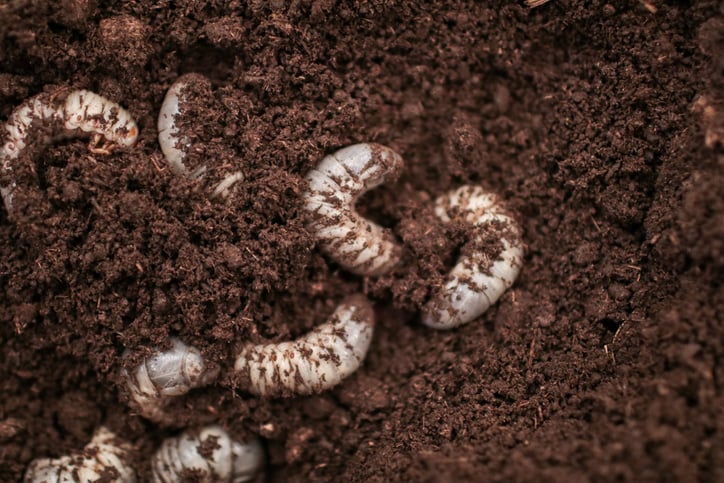Grub control is an essential part of lawn care and is necessary to protect your lawn from the damaging effects of pest infestation. Grubs are the beetles' larvae and feed on your lawn's roots, causing brown patches and making it easier for disease and drought to take hold. Some of the most common grubs are Japanese beetles and the European Chafer. And unlike other pests, grubs aren’t known for dying out in the Winter and returning in the Spring.
When To Apply Grub Control
Grubs are most active in late summer and early fall, and during this time, they cause the most damage to lawns. Warnings signs from past and present infestations include brown patches that never grow new grass, signifying that grubs were there in a past season and devoured the root system.
Spongy soil indicates that grubs dwell underground but can be hard to spot. Digging up a small cross-section of the lawn and checking for how many grubs you see is one of the best ways to diagnose your yard.
Finding some grubs is fine, as this is natural and beneficial to your lawn and its lifecycle. But you should treat your yard if you find a high quantity when looking for evidence or if beetles are abundant during early summer.
As a rule,
- Five or fewer grubs dug up per square foot is within a normal range.
- Five to Ten grubs are more concerning but won’t cause issues if your grass remains healthy.
- More than 10 grubs indicate a serious infestation that will need to be dealt with straight away.
Applying grub control in late spring or early summer, typically between April and June, will help to disrupt the lifecycle. This is when grubs are in their earliest developmental stages, and the treatment will be most effective.
Applying grub control too late in the season, after the grubs have already matured, will not be as effective as most insecticides are designed to tackle the issues of infestations during hatching.
However, while it’s always best to start with preventative measures, you may need to remove the grubs already damaging your lawn. In this scenario, the best time to apply grub control in your yard will be when you see the first signs of damage. This can happen between July and September, during the grub’s larvae stage. And by late summer and early fall, grubs are larger and more difficult to treat and have already done much of their damage to the lawn.

Getting Results with Grub Control
Like all lawn care, using the right products and techniques when applying grub control is important. Products containing Trichlorfon, such as Bayer 24-Hour Grub Killer Plus, are effective against grubs and safe for lawn use. A granular product is the easiest to apply and will give immediate results. Following the manufacturer's instructions is a must and should be followed by watering your lawn immediately. Products using imidacloprid as an active ingredient can be used as part of preventative maintenance in the spring to provide several months of protection.
Regular fertilization is also important for strengthening grass and other foliage and can be paired with regularly aerating the soil to reduce grub infestations. The beetles that spawn the most destructive grubs prefer compacted soil for their eggs. Aerating the soil is beneficial for the turf in many ways, but it is crucial in areas with a higher risk for grubs. Natural solutions include the addition of nematodes to the environment, which will infect and devour certain grub species. However, when adding anything new to your yard, there is always a chance of side effects.
Let Lush Lawn Help With Your Lawn Needs
We can help with your essential lawn decisions and determine how best to protect your yard year-round from the worst pests and most annoying insect invaders. To get a free estimate, contact Lush Lawn today.
